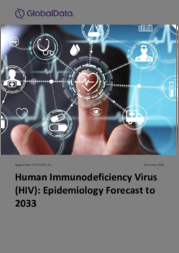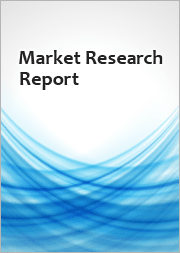
|
시장보고서
상품코드
1646655
세계의 인간 면역 결핍 바이러스(HIV) : 역학 예측(-2033년)Human Immunodeficiency Virus (HIV): Epidemiology Forecast to 2033 |
||||||
본 보고서는 주요 7개 시장(미국, 프랑스, 독일, 독일, 이탈리아, 스페인, 영국, 일본)의 인간 면역 결핍 바이러스(HIV)에 대해 조사 분석하여 위험인자, 동반질환, 과거 역학 동향에 대한 정보를 제공합니다.
목차
제1장 인간 면역 결핍 바이러스 : 주요 요약
- 촉매
- 관련 보고서
- 향후 보고서
제2장 역학
- 질환 배경
- 위험 요인과 합병증
- 세계의 과거 동향
- HIV 총유병율
- HIV 진단 유병률
- HIV 진단 이환율
- 주요 7개 시장 예측 방법
- HIV 역학적 예측(2023년-33년)
- HIV 총 유병자수
- HIV 진단 환자수
- HIV 진단 환자수 : 연령별
- HIV 진단 환자수 : 성별
- 중복 감염을 수반하는 HIV 진단 환자수
- 항 레트로바이러스 치료를 받고 있는 HIV 진단 환자수
- HIV 진단 이환자수
- HIV 진단 이환자수 : 연령별
- HIV 진단 이환자수 : 성별
- 폭로 전 예방을 받고 있는 예방 집단
- 폭로 후 예방을 받고 있는 예방 집단
- 논의
- 역학적 예측 인사이트
- COVID-19의 영향
- 분석의 한계
- 분석의 강점
제3장 부록
LSH 25.02.24Discovered in 1983, human immunodeficiency virus (HIV) is an RNA virus that reverse transcribes itself into the human host's DNA and produces lifelong infection. HIV primarily infects cells with CD4+ antigen, such as T-cells and macrophages, two essential white blood cell types (Swinkels et al., 2024) During the acute stage of infection, HIV destroys these CD4+ cells, which allows for the transmission of the virus, opportunistic infections, and the eventual development of AIDS (NIH, 2021; NIH, 2024). Symptoms occur within four weeks of exposure and include flu-like symptoms such as fever, fatigue, muscle pain, rash, and headache. Symptoms last approximately 18 days before the onset of chronic infection (Swinkels et al., 2024). Chronic HIV infection is largely asymptomatic. If untreated, it will develop into AIDS after approximately 10 years. AIDS is defined by a CD4+ cell count below 200 cells per cubic millimeter of blood or the presence of AIDS-defining conditions, such as pulmonary candidiasis, primary lymphoma of the brain, or Kaposi sarcoma (NIH, 2024; Swinkels et al., 2024)
HIV transmission occurs via contact with bodily fluids, such as can occur during unprotected sex, childbirth and breastfeeding, intravenous drug use, and needle stick (NIH, 2024). At-risk populations for HIV include people who inject drugs (PWID), children of an HIV-positive birthing person, men who have sex with men (MSM), sex workers, institutionalized people such as prisoners, and gender-diverse people (Swinkels et al., 2024).
Scope
- This report provides an overview of the risk factors, comorbidities, and the global and historical epidemiological trends for HIV in the seven major markets (7MM: US, France, Germany, Italy, Spain, UK, and Japan). It includes a 10-year epidemiological forecast for the total prevalent cases, diagnosed prevalent cases, and diagnosed incident cases of HIV segmented by age (<18 years, 18-29 years, and by 10-year age groups for 30 years up to 80 years and older) and sex. Additionally, this report provides a 10-year epidemiological forecast for the diagnosed prevalent cases of HIV on antiretroviral therapy (ART), segmented by age (<13 years, 13-17 years, and 18 years and older), as well as the diagnosed prevalent cases of HIV coinfected with hepatitis C virus (HCV) and hepatitis B virus (HBV). Coverage of the prophylactic population by pre-exposure prophylaxis (PrEP) and post-exposure prophylaxis (PEP) is also provided throughout the forecast.
Reasons to Buy
The HIV Epidemiology series will allow you to -
- Develop business strategies by understanding the trends shaping and driving the global HIV markets.
- Quantify patient populations in the global HIV markets to improve product design, pricing, and launch plans.
- Organize sales and marketing efforts by identifying the age groups and sex that present the best opportunities for HIV therapeutics in each of the markets covered.
- Understand magnitude of the HIV population by age, sex, ART coverage, HBV/HCV co-infection, as well as PrEP and PEP coverage of the prophylactic population.
Table of Contents
Table of Contents
- About GlobalData
1 Human Immunodeficiency Virus: Executive Summary
- 1.1 Catalyst
- 1.2 Related reports
- 1.3 Upcoming reports
2 Epidemiology
- 2.1 Disease background
- 2.2 Risk factors and comorbidities
- 2.3 Global and historical trends
- 2.3.1 Total prevalence of HIV
- 2.3.2 Diagnosed prevalence of HIV
- 2.3.3 Diagnosed incidence of HIV
- 2.4 7MM forecast methodology
- 2.4.1 Sources
- 2.4.2 Sources not used
- 2.4.3 Forecast assumptions and methods
- 2.4.4 Total prevalent cases of HIV
- 2.4.5 Diagnosed prevalent cases of HIV
- 2.4.6 Diagnosed prevalent cases of HIV with hepatitis B virus/hepatitis C virus coinfection
- 2.4.7 Diagnosed prevalent cases of HIV on antiretroviral treatment
- 2.4.8 Diagnosed incident cases of HIV
- 2.4.9 Prophylactic population on pre-exposure prophylaxis
- 2.4.10 Prophylactic population on post-exposure prophylaxis
- 2.5 Epidemiological forecast for HIV (2023-33)
- 2.5.1 Total prevalent cases of HIV
- 2.5.2 Diagnosed prevalent cases of HIV
- 2.5.3 Age-specific diagnosed prevalent cases of HIV
- 2.5.4 Sex-specific diagnosed prevalent cases of HIV
- 2.5.5 Diagnosed prevalent cases of HIV with coinfection
- 2.5.6 Diagnosed prevalent cases of HIV on antiretroviral treatment
- 2.5.7 Diagnosed incident cases of HIV
- 2.5.8 Age-specific diagnosed incident cases of HIV
- 2.5.9 Sex-specific diagnosed incident cases of HIV
- 2.5.10 Prophylactic population on pre-exposure prophylaxis
- 2.5.11 Prophylactic population on post-exposure prophylaxis
- 2.6 Discussion
- 2.6.1 Epidemiological forecast insight
- 2.6.2 COVID-19 impact
- 2.6.3 Limitations of the analysis
- 2.6.4 Strengths of the analysis
3 Appendix
- 3.1 Bibliography
- 3.2 About the Authors
- 3.2.1 Epidemiologist
- 3.2.2 Reviewers
- 3.2.3 Vice President of Disease Analysis and Intelligence
- 3.2.4 Global Head and EVP of Healthcare Operations and Strategy
- Contact Us

















